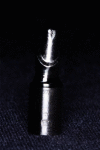Comparative fracture strength analysis of Lava and Digident CAD/CAM zirconia ceramic crowns
- PMID: 23755332
- PMCID: PMC3675299
- DOI: 10.4047/jap.2013.5.2.92
Comparative fracture strength analysis of Lava and Digident CAD/CAM zirconia ceramic crowns
Abstract
Purpose: All-ceramic crowns are subject to fracture during function. To minimize this common clinical complication, zirconium oxide has been used as the framework for all-ceramic crowns. The aim of this study was to compare the fracture strengths of two computer-aided design/computer-aided manufacturing (CAD/CAM) zirconia crown systems: Lava and Digident.
Materials and methods: Twenty Lava CAD/CAM zirconia crowns and twenty Digident CAD/CAM zirconia crowns were fabricated. A metal die was also duplicated from the original prepared tooth for fracture testing. A universal testing machine was used to determine the fracture strength of the crowns.
Results: THE MEAN FRACTURE STRENGTHS WERE AS FOLLOWS: 54.9 ± 15.6 N for the Lava CAD/CAM zirconia crowns and 87.0 ± 16.0 N for the Digident CAD/CAM zirconia crowns. The difference between the mean fracture strengths of the Lava and Digident crowns was statistically significant (P<.001). Lava CAD/CAM zirconia crowns showed a complete fracture of both the veneering porcelain and the core whereas the Digident CAD/CAM zirconia crowns showed fracture only of the veneering porcelain.
Conclusion: The fracture strengths of CAD/CAM zirconia crowns differ depending on the compatibility of the core material and the veneering porcelain.
Keywords: All-ceramic crown; Digident CAD/CAM; Fracture strength; Lava CAD/CAM; Zirconia.
Figures





References
-
- Ku CW, Park SW, Yang HS. Comparison of the fracture strengths of metal-ceramic crowns and three ceromer crowns. J Prosthet Dent. 2002;88:170–175. - PubMed
-
- Zahran M, El-Mowafy O, Tam L, Watson PA, Finer Y. Fracture strength and fatigue resistance of all-ceramic molar crowns manufactured with CAD/CAM technology. J Prosthodont. 2008;17:370–377. - PubMed
-
- Rosenstiel SF, Land MF, Fujimoto J. Contemporary fixed prosthodontics. St. Louis: Mosby; 2001. pp. 262–271.
-
- Sjögren G, Sletten G, Dahl JE. Cytotoxicity of dental alloys, metals, and ceramics assessed by millipore filter, agar overlay, and MTT tests. J Prosthet Dent. 2000;84:229–236. - PubMed
-
- Siervo S, Pampalone A, Siervo P, Siervo R. Where is the gap? Machinable ceramic systems and conventional laboratory restorations at a glance. Quintessence Int. 1994;25:773–779. - PubMed
LinkOut - more resources
Full Text Sources
Other Literature Sources
Research Materials
Miscellaneous

